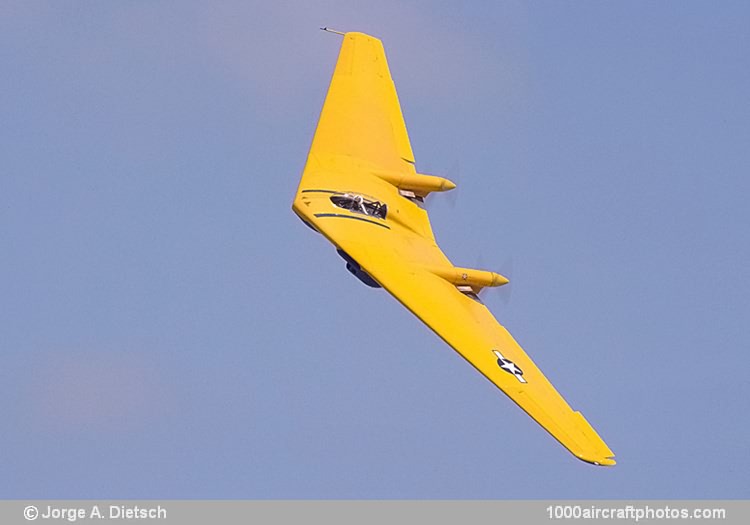08/31/2014. Remarks by Johan Visschedijk: "By 1941, John Knudsen "Jack" Northrop had demonstrated with the N-1M that the flying wing worked, and the US Army became so interested that in June 1941 Northrop received an Army contract for preliminary design of a flying-wing bomber (which became the XB-35) of breathtaking size and power. Northrop authorized construction of four scale models, to sort out the immense volume of aerodynamic, stability, control and structural data needed.
These four aircraft, which, like their predecessor, were kept secret, were designated N-9M. Like the N-1M they were pure flying wings, the shape broken only by the pilot canopy and the shaft fairings to the two pusher propellers, each of which was centered midway between the pairs of propellers of the future bomber. On a linear scale the N-9M was one-third the size of the bomber, so it weighed about 1/27th as much. Engine power was about 1/20th as much. The first three aircraft had two 275 hp Menasco Buccaneers and the fourth, a two-seater and called the N-9MB, two 300 hp Franklin O-540s. All engines were installed on their sides, driving Hamilton Standard propellers through a fluid coupling. Flight controls comprised a stick connected to the elevons, for pitch/roll control, and pedals connected to the tip decelerons for turns and asymmetric flight control. One N-9M was charged with developing the future bomber's autopilot.
The first two N-9Ms were yellow like their predecessor, but no. 3 was blue on top and yellow underneath, and no. 4 was yellow on top and blue underneath. One of the last features agreed was to use a fixed pilot seat; in emergency, the drill was to close the throttles, brake the propellers, jettison the canopy and bail out manually. In fact, in unyawed flight there was good clearance between the propellers.
The first N-9M was flown out of Northrop field, Hawthorne, by John Myers on December 27, 1942. Everything seemed fine until, on the 49th flight in March 1942, this aircraft crashed near Rosamond Dry Lake. Pilot Max Constant had been investigating stalls at full aft center of gravity, and there was evidence he may have been trapped in the cockpit by a full-aft force on the control wheel which he could not overcome and was killed on impact. Later it was found that all stall-spin characteristics were within acceptable limits. Nevertheless, to avoid future trouble a powerful hydraulic ram was installed which could push the stick forward in emergency. Through the remainder of WW II the N-9Ms flew intensively until the behavior of the bomber could be predicted with confidence. Their tight turns were breathtaking.
After the Flying Wing bomber program, all remaining N-9M flight test aircraft, except for the sole N-9MB, were scrapped. The
N-9MB was acquired in 1972 by the Planes of Fame Air Museum at Chino, California. Over the following twenty years it was restored by former Northrop employees and a number of volunteers and appropriately registered N9MB the aircraft was flown again in 1993. In April 2006 the aircraft suffered an in-flight engine fire, but was repaired and flown again in 2010."
